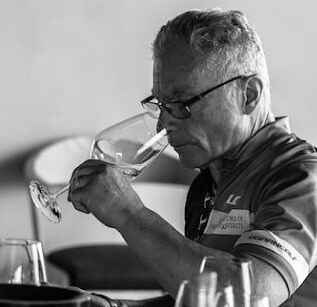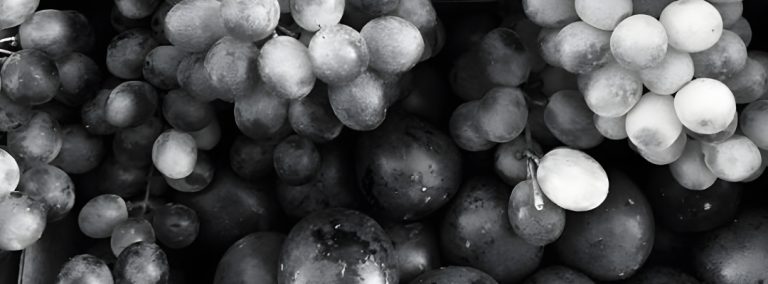Malbec and Merlot are both medium to full-bodied red wines with good structure and red fruits, however, Malbec tends to be quite linear and can have more spicy flavors, think blackberry with tobacco and cocoa. Merlot is typically more smooth, with notes of plum and cherry. Another difference is Merlot is sometimes described as being a softer wine because it has fewer tannins, though both Merlot and Malbec are less tannic than Cabernet Sauvignon. Tannins are what make your mouth pucker when you drink wine.
One of the biggest differences is where these wines come from. Malbec originated in France, but is now mostly grown in Argentina, primarily in the Mendoza region. Merlot is a French grape too, but it’s grown all over the world. If you go to your local wine store you’ll see Merlots from France, Chile, South Africa, America, the list goes on. The Malbecs will likely just be from Argentina.
In terms of wine food pairings, they go with a lot of the same foods, for example red meats like beef and lamb. However, Malbec is better if your steak is marinated and grilled, whereas Merlot is best if you’re having Steak au Poivre, or a dish served in a rich sauce.
Both of these wines fall in the same price range, yet lower priced Malbecs are often a bit better than lower priced Merlots. The reason for this difference is there’s more bulk Merlot on the market. You can find an excellent Malbec in the $18 to $25 range whereas with Merlot you usually need to hit a minimum of $20-$35 for the wine to be of the same quality level.

What are the key differences
- How they taste. Both wines have red fruit and dark berries in their taste profile and sometimes hints of chocolate. The difference is you get spice in Malbec that Merlot just doesn’t have. With Merlot there’s more plum and red cherry fruit. Note, oak aging will give some Malbecs and Merlots notes of vanilla in the finish.
- How they look. Both wines are deep colored and opaque, but Malbec has purple and violet in it, while Merlot is mainly a ruby red color. If you look closely at a glass of Malbec you might even see some blue tones, especially if you’re looking at the edge of your wine glass.
- Where they’re grown. Malbec is mostly from Argentina. The other major Malbec wine growing region is where the grape comes from in Cahors, France. Merlot, on the other hand, is produced all over the world. It’s one of the main grapes in many Bordeaux blends and in Italy, it often goes into the Super Tuscans. Chile grows Merlot, as does Washington State and California (Long Island too!). There’s Merlot from South Africa, Australia and New Zealand as well.
- The texture of the wine. There can be a difference to the mouthfeel of the wine. Merlot can be more velvety and have a richer texture, though it does vary depending on where the grapes are grown. Merlot made from vineyards planted on a hillside can produce wine so structured you might even mistake it for a Cabernet Sauvignon!
- How much they cost. Merlot can vary widely in price whereas Malbec is more in the $15-$25 range with reserva wines and top Malbecs costing between $40-$150. Merlot is relatively easy to grow so it goes into a lot of bulk wine, which can be quite cheap at $7-8 a bottle. That’s not to say it always costs less. One of the most expensive wines in the world is a Merlot-blend. The main takeaway is that “the floor of Malbec” is higher than “the floor of Merlot” so you’ll need to spend an extra $5+ on Merlots to have the same quality level.
Differences and similarities
There are a number of differences between these wines but they can also be quite similar! Neither has high acidity, and both are dry and medium to full-bodied wines. Dry means the wine doesn’t have much residual sugar which would make it taste sweet. Merlot and Malbec are wines that can age, and compared to Cabernet, they tend to be more approachable. This is because they contain lower tannins, meaning the wine is easier to drink when young. They pair with many of the same foods and are excellent with red meats. They also present some of the best values for red wines in the mid price-level range.
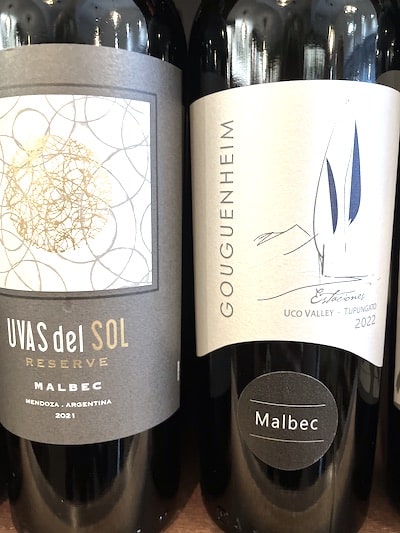
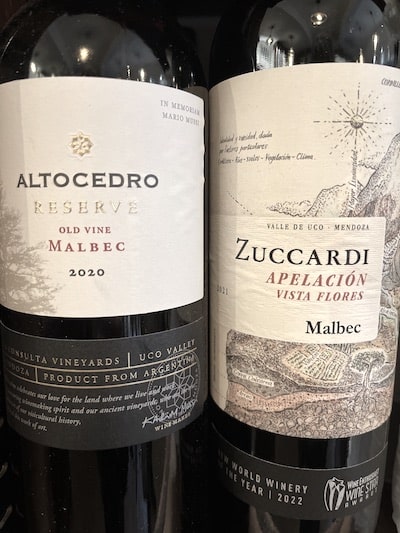
More on Malbec
Malbec is basically Argentina’s signature wine. In fact, Argentina is where 70-80% of the world’s production comes from. Malbecs are deep and opaque wines with bold fruit flavors, and hints of chocolate and spice. They’re dry and medium to full in body with good acidity, especially when they come from higher elevations.
This is a wine that’s described as having precision to its fruit (some might even call it bold!). An unoaked Malbec will be a pretty wine with bright red fruit notes, including raspberries and plum. However, Malbec is often aged in oak and this gives it vanilla notes and more texture. It’s also a wine that becomes more complex as it ages.
Wine Tip: Malbec is originally from Cahors, France where they make a rustic style that’s quite tannic with earthy flavors. The French wine is known by the traditional name for the grapes, Côt. Note, Malbec is also increasingly found in California as a blending partner for Cabernet Sauvignon.
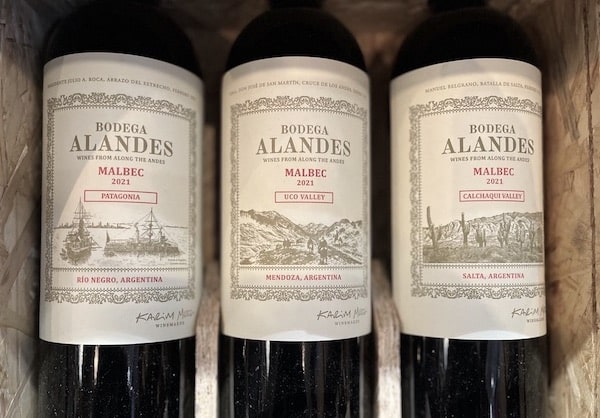
How did Malbec get to Argentina?
Malbec was originally a grape varietal from Bordeaux and the nearby Cahors region of France. When phylloxera hit French vineyards, many winemakers left for regions that weren’t affected. South America was a popular destination, in particular Argentina.
Cuttings of Malbec were planted in the high elevation semi-desert area of Argentina’s Mendoza region and it didn’t take long to realize Malbec grapes grow exceptionally well in this climate. The combination of more exposure to direct sunlight and the big temperature difference between night and day was perfect for them. With increased exposure to ultraviolet light, the grapes grew thicker skins to protect themselves. Skin gives wine its color, along with tannins, flavor and aroma compounds. This is why Argentinian Malbec tastes so different from Malbec from France.
Malbec also seemed to like the soil in the region, which is quite sandy with plenty of minerals and quartz. The Incas had already built a series of canals and dams to capture the melting snow. This was just the irrigation system the vineyards needed to be successful, and the rest is history!
Wine Fact: Ninety percent of the wines that come out of Argentina are produced in the Mendoza region. The area of Cuyo in Mendoza is known as the “land of sand.”
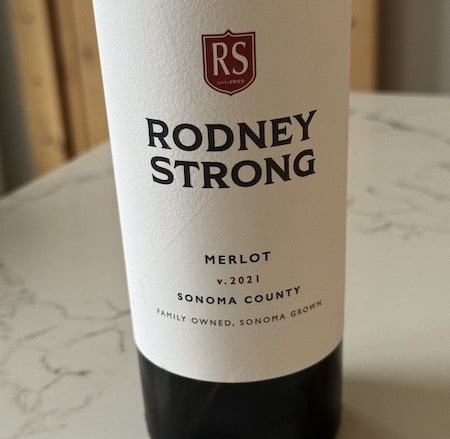
Tasting notes for Merlot
Merlot is a French varietal that’s best known for its softer texture. It tends to make dry, bright, and fruity wines with luxurious flavors and fewer tannins. The grapes have good acidity and are a deep ruby in color with characteristic notes of plum, blackberry and cherry, along with hints of chocolate.
The thing to know about Merlot is it’s an early ripening varietal, which means it’s easy to grow in different climates and soils. While it’s one of the most planted vines in Bordeaux, you can also find wine that’s 100% Merlot or a Merlot-blend in most countries, from Italy to America, Australia, Africa and even Argentina’s neighbor, Chile!
Nonetheless, Merlot changes depending on where and how it’s grown and therefore the wine’s quality can vary significantly. This is a nice way of saying there’s some nondescript Merlot out there. Bulk produced wine lacks distinction and character.
On the flip side, there’s a lot of high quality wine too! Top Merlot producers in the US include Duckhorn in California and Leonetti Cellars in Washington State. Chateau Petrus, is considered one of the greatest wines of Bordeaux and it’s 98-100% Merlot.
Insider Wine Tip: Merlot is a wine commonly served at large functions. Depending on how much you’re paying, it won’t necessarily be the best glass you’ve ever had. Nevertheless, cheap Merlot is generally better than cheap Cabernet!
Trends that affect wine consumption
In the early 2000s, Merlot wasn’t as trendy of a wine as Malbec. This was due in part to the influence of a movie called Sideways in which one of the main characters trash-talked the grape saying it was unexciting, soft, and made “wimpy wines.” At around the same time, Malbec benefited from an upswing in popularity as more restaurants began to carry it and sell Malbec by the glass. Today, things have more or less evened out. Malbec is less in vogue than it used to be and Merlot is coming back. Still, it’s important to be aware of these differences and how our perception of wine can be so easily influenced by what’s trending!
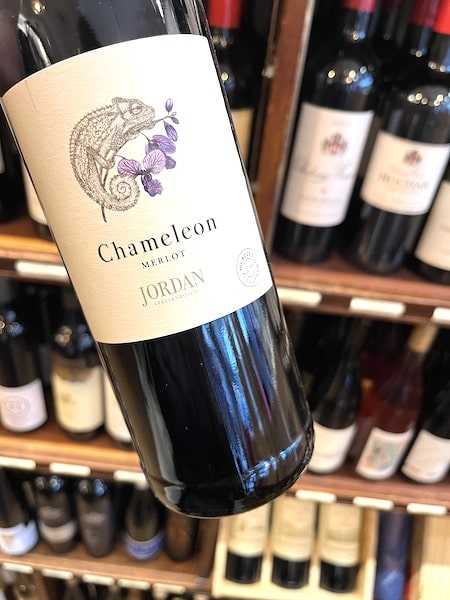
5 Tips if you’re deciding between Malbec and Merlot for dinner
- Make your meal stand out with a high-end Malbec. The Uco Valley and Lujan de Cuyo are sub-districts of Mendoza that make exceptional Malbecs. Instead of ordering that Napa Cabernet, try an upper-end Malbec with your sirloin. Note, these wines can also be aged if you want to put a few bottles in your cellar for a special occasion.
- Elevate the evening with a classic Merlot-blend. Some of the best wines from Bordeaux are Merlot-blends. Look for a wine from the Pomerol or Saint-Emilion areas of Bordeaux where Merlot is the major grape.
- Order Merlot if you’re having a classic chicken dish. It will be smooth and medium-bodied with fruity notes that go nicely with most chicken dishes. Malbec can have too many tannins and is best suited to barbecue chicken in a spicy sauce.
- Try a value Merlot from Chile. Merlot is Chile’s second most planted grape and you can count on the quality of the wine being great for the price – a $10 Merlot from Chile will probably be better than a $10 bottle from California. Chilean Merlot tends to be medium to full-bodied with good acidity and fruit flavors. It’s a wine that’s easy to drink.
- Pair a spicy Malbec with food that has some heat to it. If you’ve ordered something spicy, it’s best to choose a wine that can stand up to the bold flavors. Merlot might be smooth but it doesn’t have the flavor profile and spice of Malbec.
More on the best wine food pairings
Malbec
Malbec is an ideal wine for pairing with a strip sirloin or other lean red meats. Its earthy character also makes it a natural pairing for game and any food you’re planning to put on the grill. Serve it alongside grilled meats cooked in barbecue sauce or sweet chili marinades. Malbec is a perfect medium body wine to have with smoked foods, particularly given its tobacco and cocoa notes. It goes with pub food like black and blue burgers too!
Merlot
Merlots make the best pairings for food served in a rich sauce. They are softer and fleshier and an ideal wine to open if you’re cooking duck or even roasting a turkey. This is especially the case if the wine has had oak aging. Don’t forget you may get some vanilla notes with oak aging. A more expensive Merlot can be an excellent wine for pairing with braised short ribs, lamb or veal shank.
Food Wine Tip: Cabernet, Malbec and Merlot are three red wines you’ll commonly see served with food, and in particular, red meat.

